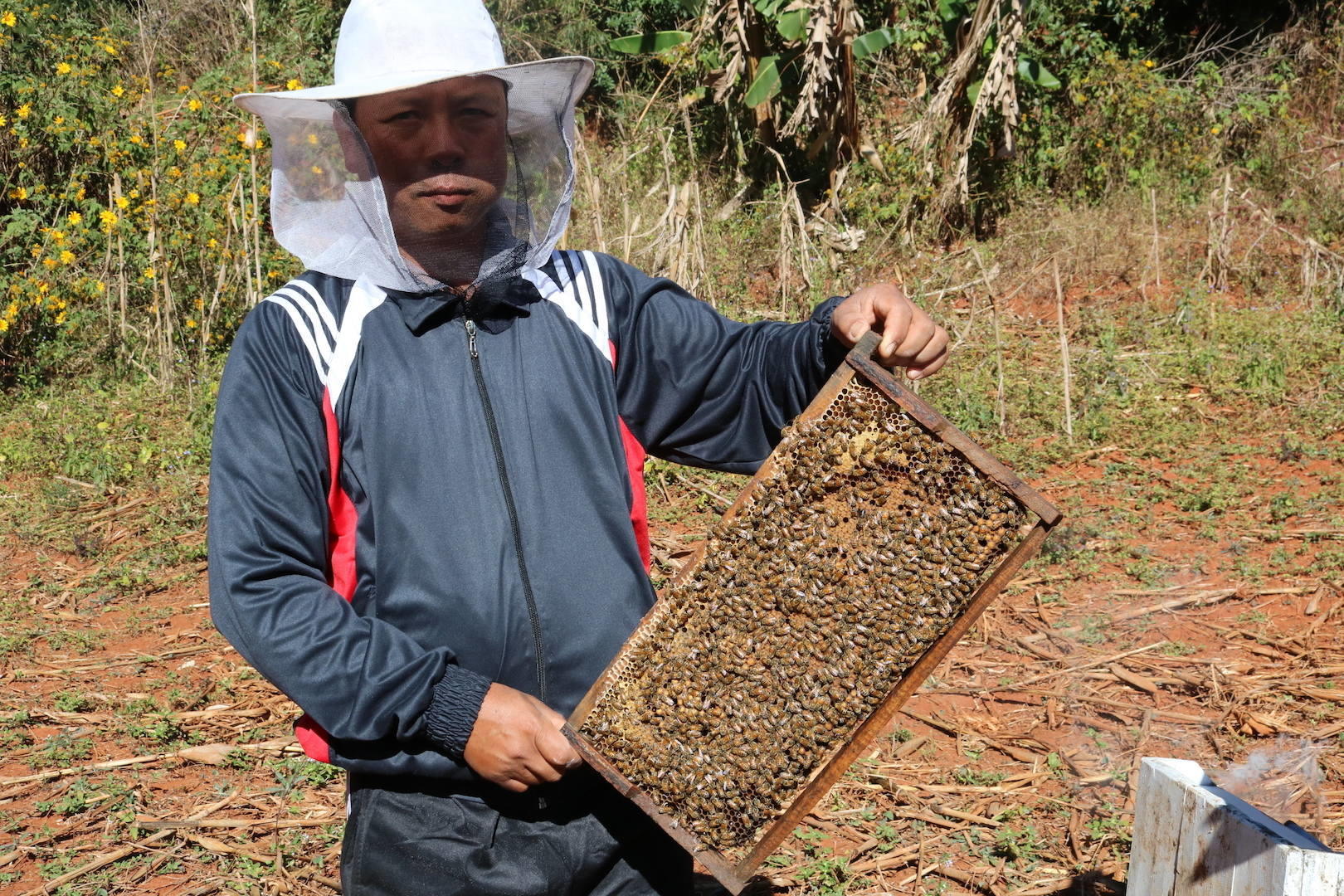Beekeeping is seen as an effective way to raise incomes in rural areas and hundreds of farmers are being trained how to produce honey in Shan State.
By Aung Nyein Chan / Myanmar Now
KYAUK HTET VILLAGE, Shan State — Until a few years ago, the farmers in Kyauk Htet Village paid little attention to the wild bees that were living around them in the farm fields, fruit trees and forests that cover the rolling Shan Hills here in Kalaw Township.
“In the past, we only ate bee larvae and destroyed the natural bees nests in the forest to take out the honey. But after we attended a training course we realised bees are beneficial insects,” said Zaw Myo Thein.
Now, he and hundreds of other small farmers in southern Shan State have boosted their income through apiculture and they are trained – and enthusiastic – beekeepers.
“Extra income from beekeeping has generated enough money for the school fees of my son. I would not be able to send him to the town school without it,” said Zaw Myo Thein. He keeps around 100 hives next to his wheat field after starting with four when he first received training from the Plan Bee Project.
“I had no interest in this business as I was very afraid of bees. However, after the training course I got familiar with the bees and I’m no longer afraid and can make money from this business,” Zaw Myo Thein said, adding that he earned almost $1,000 from honey sales last year.
Hein Hein Tun, another beekeeper and farmer in nearby Pindaya Township, estimated he made about $1,100 in 2016. “My current income has increased compared to the starting period,” he said.
San Win, secretary of the Beekeeping Business Association of Shan State, explained each hive has around 30,000 workers and one queen who live off the flowers in nearby fields. He said most bees in Shan State make honey collected from the nectar of flowering plum trees, adding that when there are few flowering crops and trees keepers feed their colonies syrup.
San Win, who keeps 400 beehives, said a kilo of honey fetches around $0.75-1 at the farm and each hive can produce up to 400 kilo annually, while it costs about $60 to maintain a hive.

PLAN BEE
Implemented by NGO TAG, the project began training farmers and providing beehives in 2013; it also supports the honey market chain development in Myanmar. Plan Bee has worked with the Ministry of Agriculture’s Apiculture Enterprise to train about 500 farmers in 20 villages in five townships in Shan State, an area home to poor Shan and Pa-O villagers.
The project is funded by the Livelihoods and Food Security Trust Fund (LIFT), a poverty reduction donor fund supported by 12 governments.
“Early trainees have established their own businesses. We just have to boost their business with some support,” said Tin Maung Kyi, a Plan Bee project manager.
Khin Mya Oo, director of the project’s Apiculture Resource and Business Centre, added, “We are doing marketing for retail and wholesale markets for the bee products of the trainees.”
Beekeeping provides a number of benefits beyond income from its relatively high-value product honey. “Bees are agents that support agriculture by carrying pollen,” Zaw Myo Thein noted.
Beehives also produce wax that can be used to make other products such as candles, while honey has nutritional value for local households, according to TAG’s project website, which added that beekeeping requires little space, making it accessible for landless families.
TAG estimates more than 100,000 people gain additional income from the honey production that it supports.
EXPORT POTENTIAL
Last year, Myanmar had more than 950 registered beekeepers with almost 150,000 hives, mostly located in the central regions. These produced around 4,500 metric tons of honey, some three-quarters of which is destined for export largely to other Asian countries, according to the government’s Apiculture Enterprise. The number of beekeepers and hives has roughly doubled in the last three years.
Myanmar has much potential to further expand its honey production, but should improve its hygiene and processing standards in the production process in order to expand access to global markets, such as the United States, said Tin Maung Kyi, of Plan Bee.
“Modern equipment should be used to produce better quality of honey to expand the market,” he said.
China is the world’s largest honey exporter and in Southeast Asia, Vietnam is a major producer, which earns around $132 million from annual honey export, according to international trade statistics.
A LIFT-supported workshop on honey production in March 2016 highlighted great expansion potential for Myanmar, as well as hurdles and risks to growth.
Experts pointed to an urgent need for better government regulation of the growing use of chemical pesticide and fertiliser in Myanmar, which threaten bee populations. Another problem is the decline in global honey prices and demand in recent years, which has also brought down prices for beekeepers in Myanmar.
Naing Oo, manager at the Shwe Pan Honey Production Company, which exports to Japan, Thailand and the United States, said he had been impacted by global market developments.
“The demand is quite cool this year, although I still shipped out about 500 tonnes of honey last year,” he said, adding that Myanmar struggled to compete with low-priced honey from Vietnam.
“Myanmar honey’s quality is quite good, but foreign merchants prefer lower priced honey for their profits. Only if the United States cannot buy more honey from the Vietnam they try to purchase from our market,” he said.
(Editing by Paul Vrieze)




